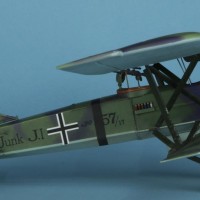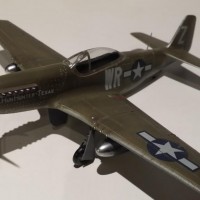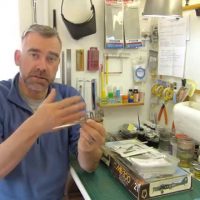Hasegawa 1/48 F-14A Tomcat
During the 60s, the USN sought a long range high performance interceptor to defend its fleet. For this Fleet Air Defense (FAD) aircraft and in favor of versatility, the Navy was directed by Secretary of Defense Robert McNamara to participate with the USAF in the so called Tactical Fighter Experimental (TFX) program. Though the TFX (which would become the F-111) was fast with long range and high payload, it lacked the much needed by the Navy maneuverability and overall performance.
The plane was essentially designed around the TF30 engine, the AWG-9 radar and the AIM-54 Phoenix missile, with plans to replace the engines with F401-400 then in development. Interestingly and on par with the F-15, no prototypes were built, with the first flight taking place on 21 December 1970 and operational status being reached in less than three years afterwards.
During the mid 1980s it was decided to replace the existing TF30 engine with the F110-GE-400. A few years later, the F-14D was introduced, which, apart from the F-110s, featured digital avionics, a glass cockpit and, equally importantly, a Digital Flight Control System (DFCS) which significantly improved its handling qualities.
The Tomcat served as the U.S. Navy's primary maritime air superiority fighter, fleet defense interceptor and tactical aerial reconnaissance platform well into the 2000s. It was retired by the U.S. Navy on 22 September 2006, supplanted by the Super Hornet. Having been exported to Pahlavi Iran under the Western-aligned Shah Mohammad Reza Pahlavi in 1976, a number of examples still (2024) remain in service with the Iranian Air Force.
Nicknamed “Jolly Rogers” and based at NAS Oceana, VF-84 Squadron was originally established as VA-86 on 1 July 1955 and was immediately redesignated as VF-84.
Throughout the Gulf War, the Squadron members flew 468 combat sorties, with an additional 111 post war in support of Operation Provide Comfort before Roosevelt was relieved by Forrestal in June 1991. In March 1993 the Squadron redeployed on Theodore Roosevelt, flying critical TARPS reconnaissance missions during Operation Deny Flight, providing information about Bosnian Serb positions around Sarajevo.
Hasegawa came in 1988 with their very nice 1/48 F-14A, reboxing it more than 40 times ever since and practically covering (with the occasional addition of some extra parts) all Tomcat versions. Though being 35 years old (as of 2024) and despite the presence of newer kits that might offer more in terms of detail and buildability, these are still very nice offerings and can produce really accurate Tomcats.
https://modelingmadness.com/review/mod/us/usn/fighter/pen14.htm
Happy Modelling!
















That is a very good looking build Spiros, @fiveten. Great job on the background about the F-14 and your build. It turned out great, and it looks like the decals worked nicely for you. One thing about modern aircraft is they sure do have a lots of stencils and other markings. Well done!
Thank you kindly, my friend @luftwaffe-birdman!
What a wonderful build, Spiros @fiveten
The chosen scheme is really nice.
Thanks a lot for sharing the history about this iconic aircraft.
Thank you so much, my friend @johnb!
That’s a cool looking cat, @fiveten !
You did a great work on it
Thank so much, my friend @ssgt!
That‘s how a Tomcat should look! Very nice paintjob and great wear&tear traces on those wings, Spiros @fiveten!
Thank you very much, my friend @fxrob!
This seemed like a very quick build, Spiros (@fiveten). Looks really nice with some subtle weathering. Hopefully you left the wings free to move so it doesn't take up so much shelf space. I have a FineMolds F-14A that I want to build soon. Well done.
Thanks a lot, my friend @gblair! The kit had been started long ago, only to be finalized lately. Unfortunately the wings cannot be left unglued, so the model takes a big amount of shelf space.
A great looking Tomcat, Spiros, interesting history, definitely Too Gun.
Thank tou kindly, my friend @chinesegeorge!
Awesome looking Tom! Brilliant work as always, Spiros!
Thanks a lot, my friend @neilroos!
Very nice Turkey, Spiros. That Hase is a beast to build though.
Thanks so much, my friend @dbdlee! Indeed, that Hase kit is challenging.
Very informative Tomcat article, Spiros. And what a superb replica you’ve created here. Looks terrific. l’ll bet you spent a fair amount of time applying all those tiny stencils.
Thank you very much, my friend @eb801!
Yes, those stencils took some time to be applied!
Beautiful build Spiros, love that paint scheme !
Thank you very much, my friend @ramair67!
Great job, Spiros. Classic scheme.
Thanks my friend @gwskat!
Well done sir on a not so easy kit! Thanks for sharing.
Rod
Thank you kindly, my friend @rodbettencourt!
Another fun read. Well done!
Thank you o much, my friend @jsummerford!
Awesome. @fiveten Anytime Baby!
Thank you very much, my friend @beauslx!
That is a classic, Spiros, and so well done, my friend! 👏 @fiveten, That's a beauty! 🤩
Thanks so much, my friend @garybrantley!
Beautifully built, I like it a lot.
Thank you kindly, my friend @milantesar!
Very nice subtle weathering, love it
Thank you very much, my friend @blackadder57!
A good-looking Tomcat!
Thank you so much, my friend @gkittinger!